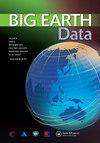Understanding spatial patterns in the drivers of greenness trends in the Sahel-Sudano-Guinean region
IF 3.8
3区 地球科学
Q1 COMPUTER SCIENCE, INFORMATION SYSTEMS
引用次数: 4
Abstract
ABSTRACT The region-wide spatial pattern of the drivers of vegetation trends in the African Sahel-Sudano-Guinean region, one of the main drylands of the world, has not been fully investigated. Time-series satellite earth observation datasets were used to investigate spatiotemporal patterns of the vegetation greenness changes in the region and then a principal component regression method was applied to identify the region-wide spatial pattern of driving factors. Results find that vegetation greening is widespread in the region, while vegetation browning is more clustered in central West Africa. The dominant drivers of vegetation greenness have a distinct spatial pattern. Climatic factors are the primary drivers, but the impacts of precipitation decrease from north to south, while the impacts of temperature are contrariwise. Coupled with climatic drivers, land cover changes lead to greening trends in the arid zone, especially in the western Sahelian belt. However, the cluster of browning trends in central West Africa can primarily be attributed to the human-induced land cover changes, including an increasing fractional abundance of agriculture. The results highlight the spatial pattern of climatic and anthropic factors driving vegetation greenness changes, which helps natural resources sustainable use and mitigation of climate change and human activities in global dryland ecosystems.了解萨赫勒-苏丹-几内亚地区绿化趋势驱动因素的空间格局
非洲萨赫勒-苏丹-几内亚地区是世界上主要的旱地之一,其植被趋势驱动因素的区域范围空间格局尚未得到充分研究。利用卫星对地观测时序数据研究了该区域植被绿度变化的时空格局,并应用主成分回归方法识别了驱动因子的区域空间格局。结果发现,该地区的植被普遍变绿,而西非中部的植被褐变更为集中。植被绿度的主导驱动因子具有明显的空间格局。气候因子是主要驱动因子,但降水的影响由北向南递减,而温度的影响则相反。在气候驱动因素的作用下,土地覆被变化导致了干旱区特别是萨赫勒西部地区的绿化趋势。然而,西非中部的褐变趋势集群可主要归因于人为引起的土地覆盖变化,包括农业的部分丰度增加。研究结果揭示了驱动植被绿度变化的气候因子和人为因子的空间格局,有助于全球旱地生态系统自然资源的可持续利用和减缓气候变化和人类活动。
本文章由计算机程序翻译,如有差异,请以英文原文为准。
求助全文
约1分钟内获得全文
求助全文
来源期刊

Big Earth Data
Earth and Planetary Sciences-Computers in Earth Sciences
CiteScore
7.40
自引率
10.00%
发文量
60
审稿时长
10 weeks
 求助内容:
求助内容: 应助结果提醒方式:
应助结果提醒方式:


